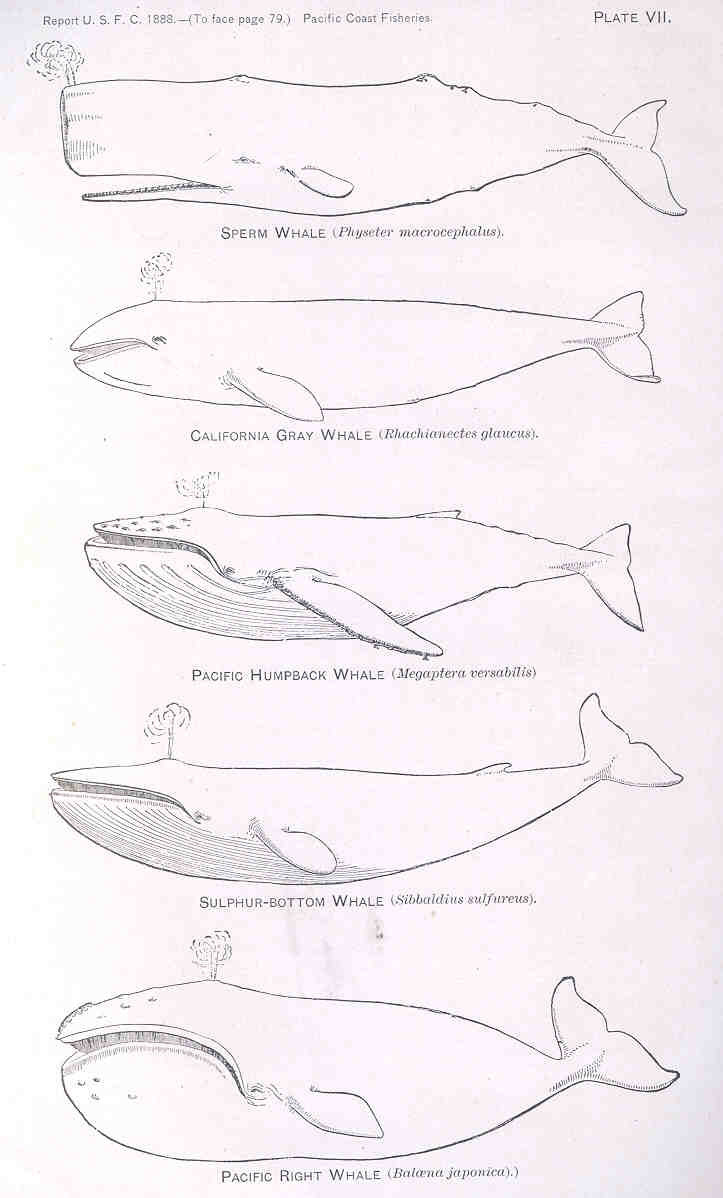|
| 질의: killer whale | 결과: 148번째/270 | |
Sperm Whale (Physeter macrocephalus), California Gray Whale (Eschrichtius robustus), Humpback Whale (Megaptera novaeangliae), Blue Whale (Balaenoptera musculus), North Pacific Right Whale (Eubalaena japonica)
| 제목: | Sperm Whale (Physeter macrocephalus), California Gray Whale (Eschrichtius robustus), Humpback Whale (Megaptera novaeangliae), Blue Whale (Balaenoptera musculus), North Pacific Right Whale (Eubalaena japonica)
| | 올린이: | Wiki Photos (---@---.---)
| |

| 해상도: 723x1198
파일크기: 85797 Bytes
등록시간: 2024:01:19 15:34:20
|
Author Joseph William Collins (1839–1904)
Sperm Whale (Physeter macrocephalus), Gray Whale (Eschrichtius robustus syn. Rhachianectes glaucus), Pacific Humpback Whale (Megaptera novaeangliae syn. M. versabilis), Sulphurbottom Whale (Balaenoptera musculus syn. Sibbaldius sulfureus), Pacific Right Whale (Eubalaena japonica)
English: Sperm Whale (Physeter macrocephalus);; California Gray Whale (Rhachianectes glaucus);; Pacific Humpback Whale (Megaptera versabilis);; Sulphur-Bottom Whale (Sibbaldius sulfureus);; Pacific Right Whale (Balaenia japonica)
Subject: Whales, Sperm whale, California gray whale, Humpback whale, Balaenidae
Tag: Aquatic Mammals
Date 1888/1889
Source/Photographer English: Collins, J. W. (1892) Report on the Fisheries of the Pacific Coast of the United States, Report of the Commissioner (United States Commission of Fish and Fisheries), 1888/1889, Washington, DC: Government Printing Office
Source: https://commons.wikimedia.org/wiki/File%3AFMIB_33382_Sperm_Whale_%28Physeter_macrocephalus%29%3B%3B_California_Gray_Whale_%28Rhachianectes_glaucus%29%3B%3B_Pacific_Humpback_Whale_%28Megaptera.jpeg
*** Sperm Whale (Physeter macrocephalus) ***
The sperm whale or cachalot (Physeter macrocephalus) is the largest toothed predator of the family Physeteridae. It is known for its enormous square-shaped head and the biggest brain of any animal on Earth. The sperm whale is a pelagic mammal with a worldwide range, and will migrate seasonally for feeding and breeding. Females and young males live together in groups, while mature males (bulls) live solitary lives outside of the mating season. The females cooperate to protect and nurse their young. A mature sperm whale has no natural predators, although calves and weakened adults are sometimes killed by pods of killer whales (orcas). Spermaceti (sperm oil), from which the whale derives its name, was a prime target of the whaling industry, and was sought after for use in oil lamps, lubricants, and candles. Ambergris, a solid waxy waste product sometimes present in its digestive system, is still highly valued as a fixative in perfumes, among other uses.
Order: Artiodactyla > Infraorder: Cetacea > Family: Physeteridae > Genus: Physeter > Species: Physeter macrocephalus
*** California Gray Whale (Eschrichtius robustus <= Rhachianectes glaucus) ***
The California gray whale (Eschrichtius robustus) is a baleen whale that migrates between feeding and breeding grounds yearly. It is identified by its mottled gray color and low hump in place of a dorsal fin. The gray whale reaches a length of 14.9 meters, a weight of up to 41 tonnes, and lives between 55 and 70 years. The gray whale was once hunted extensively for its meat, oil, and baleen. In the 20th century, the gray whale was hunted to the brink of extinction, but has since made a remarkable recovery.
Order: Artiodactyla > Infraorder: Cetacea > Family: Eschrichtiidae > Genus: Eschrichtius > Species: Eschrichtius robustus
*** Pacific Humpback Whale (Megaptera novaeangliae <= Megaptera versabilis) ***
The humpback whale (Megaptera novaeangliae) is a species of baleen whale. It is a rorqual (a member of the family Balaenopteridae) and is the only species in the genus Megaptera. Adults range in length from 14–17 m and weigh up to 40 metric tons. The humpback has a distinctive body shape, with long pectoral fins and tubercles on its head. It is known for breaching and other distinctive surface behaviors, making it popular with whale watchers. Found in oceans and seas around the world, humpback whales typically migrate up to 16,000 km each year. They feed in polar waters and migrate to tropical or subtropical waters to breed and give birth. Their diet consists mostly of krill and small fish, and they use bubbles to catch prey.
Order: Artiodactyla > Infraorder: Cetacea > Family: Balaenopteridae > Genus: Megaptera > Species: Megaptera novaeangliae
*** Blue Whale (Balaenoptera musculus) <= Sulphur-Bottom Whale (Sibbaldius sulfureus) ***
The blue whale (Balaenoptera musculus) is a marine mammal and a baleen whale. It is the largest animal known to have ever existed, reaching a maximum confirmed length of 29.9 meters and weighing up to 199 tonnes.
Order: Artiodactyla > Infraorder: Cetacea > Family: Balaenopteridae > Genus: Balaenoptera > Species: Balaenoptera musculus
*** North Pacific Right Whale (Eubalaena japonica) ***
The North Pacific right whale (Eubalaena japonica) is a very large, thickset baleen whale species that is extremely rare and endangered. It can reach a length of 15-20 meters and weigh up to 100,000 kg. The Northeast Pacific population, which summers in the southeastern Bering Sea and Gulf of Alaska, may have no more than 40 animals. A western population that summers near the Commander Islands, the coast of Kamchatka, along the Kuril Islands and in the Sea of Okhotsk is thought to number in the low hundreds.
Order: Artiodactyla > Infraorder: Cetacea > Family: Balaenidae > Genus: Eubalaena > Species: Eubalaena japonica |
^o^
동물그림창고 똑똑전화 누리집
^o^
|
|